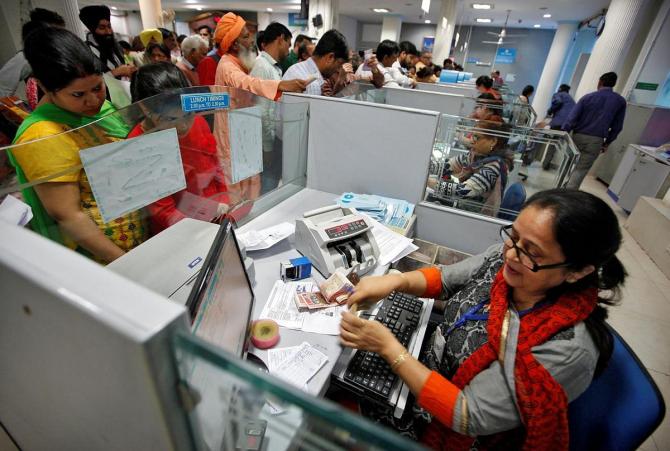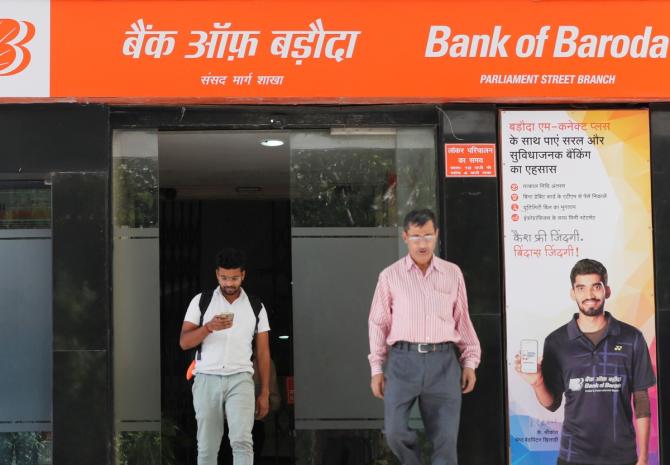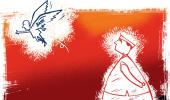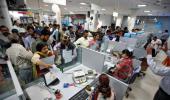If the earnings in the first quarter of the current financial year are an indication, most banks, particularly those majority-owned by the government, have fared well, reveals Tamal Bandyopadhyay.

In March 2021, the gross non-performing assets (GNPAs) of the Indian banking system were 7.5 per cent of advances.
After setting money aside for provisions, the net NPAs (NNPAs) were 2.4 per cent.
Most of the banks could stomach the impact of the Covid pandemic with a brave face in a year when the economy had shrunk and the loan portfolio grew at a record low of 5.6 per cent even as the regulator had frozen repayment of loans for months and allowed banks to restructure loans.
The Reserve Bank of India's latest Financial Stability Report estimates that banks' GNPAs may rise to 9.80 per cent in the baseline scenario by March 2022.
In a severe stress scenario, they can rise to as much as 11.22 per cent.
If the earnings in the first quarter of the current financial year are an indication, most banks, particularly those majority-owned by the government, have fared well.
At Rs 32,096 crore (Rs 320.96 billion), the collective net profit of listed banks in the June quarter has risen 61 per cent from the year-ago quarter.
Public sector banks (PSBs) have done better than their private peers.
Their year-on-year net profit is up 140 per cent, from Rs 5,847 crore (Rs 58.47 billion) to Rs 14,012 crore (Rs 140.12 billion).
In contrast, listed private banks' net profit has risen 28 per cent, from Rs 14,127 crore (Rs 141.27 billion) to Rs 18,083 crore (Rs 180.83 billion).
The data doesn't include the earnings of Jammu & Kashmir Bank Ltd, which posted Rs 104.95 crore (Rs 1.0495 billion) net profit in June 2021 against Rs 7.3 crore (Rs 73 million) a year ago.
As the government is committed to privatise IDBI Bank Ltd, I have clubbed it with private banks in the hope that its existential crisis will end soon.
PSBs have put up a better show than private banks when it comes to operating profit, too.
It has risen over 16 per cent, almost double that of private banks.
Overall, listed banks' operating profit in June 2021 is just over Rs 1 trillion, rising 12.24 per cent over June 2020.
Despite a modest growth in operating profits, the net profit of some banks could grow phenomenally because of relatively lower provisioning for bad assets.
Overall, their provision and contingencies dropped over 9 per cent in the June quarter -- from Rs 62,796 crore (Rs 627.96 billion) to Rs 56,964 crore (Rs 569.64 billion).
While for private banks, it dropped a little over 7 per cent, for PSBs, the drop is sharper -- close to 11 per cent.
As a result, the provisioning coverage ratio, or the percentage of funds that a bank sets aside for covering losses due to bad debts, has not gone up for every bank.
I have not been able to access the coverage ratio of all, but among those available, IDBI Bank has the highest (97.42 per cent).
Indian Overseas Bank and Bank of Maharashtra have at least 90 per cent provisioning coverage ratio, while all other PSBs have more than 80 per cent, displaying strength of balance sheets.

PSBs have shown close to 35 per cent rise in their fee income in the June quarter, against 20.5 per cent in private banks.
However, when it comes to net interest income, private banks have done better than PSBs.
Their net interest income in the June quarter is up 10.6 per cent, almost double that of PSBs.
While the deposit portfolios of all banks have grown, some have pared growth in their advance portfolios.
This is why the net interest income has declined for quite a few banks.
Among large banks, State Bank of India's loan book in June has grown 5.8 per cent, while HDFC Bank Ltd and ICICI Bank Ltd have shown 14.4 per cent and 17 per cent growth, respectively.
Among all listed banks, Kotak Mahindra Bank Ltd has the highest quantum of low-cost current and saving accounts or CASA -- 60.2 per cent of all deposits in June 2021.
Only three other banks have more than 50 per cent CASA.
These are Bank of Maharashtra (53 per cent), IDBI Bank (close to 52.5 per cent) and IDFC First Bank Ltd (close to 51 per cent).
Central Bank of India, State Bank of India and HDFC Bank have more than 45 per cent but less than 50 per cent CASA.
The reason behind lower provisioning is lower growth in bad loans.
In absolute terms, the GNPAs of listed banks have dropped 2.5 per cent, from Rs 8.32 trillion in June 2020 to Rs 8.11 trillion in June 2021. Here too, PSBs have done better than private banks.
Their GNPAs have dropped 4.2 per cent, while private banks' GNPAs have risen 3.3 per cent.
The contrast is sharper when we look at NNPAs.
Overall, the pile has risen by half a per cent (from Rs 2.52 trillion to Rs 2.53 trillion), but PSBs have shown a 4 per cent decline in net NPAs, while private banks' NNPAs have grown close to 22 per cent.
IDBI Bank has the highest GNPAs (22.71 per cent), followed by Yes Bank Ltd (15.6 per cent).
No other private bank has double-digit GNPAs.
In the pack of PSBs, led by the Central Bank (15.92 per cent), six have double-digit GNPAs.
After provisioning, four banks have more than 5 per cent NNPAs.
These are Punjab National Bank (5.84 per cent), Yes Bank (5.78 per cent), Central Bank (5.09 per cent) and South Indian Bank (5.05 per cent).
Most of the PSBs have been able to bring down their NNPAs in the June quarter from a year ago and even March 2021. But this is not the case with private banks.
The good news is that even though the two waves of the pandemic have dented the quality of retail assets, the quality of corporate loans has by and large remained unaffected.
A recent Credit Suisse report says corporate asset quality cycle recovery has helped banks contain NPAs; the driver of this is improved profitability in stressed sectors such as metals and power and deleveraging by some large corporations.
It's too early to comment on the banks' ability to hold out against the second wave of the pandemic -- particularly when no one knows in what form the third wave, if there is one, will attack us.
But, for now, backed by the regulator and the government, the banking system has surprised us with its resilience.
If increasing vaccination and economic recovery unleash pent-up consumer demand, the worst could be behind them.
Tamal Bandyopadhyay is a consulting editor with Business Standard, is an author and senior adviser to Jana Small Finance Bank Ltd.
Feature Presentation: Rajesh Alva/Rediff.com











